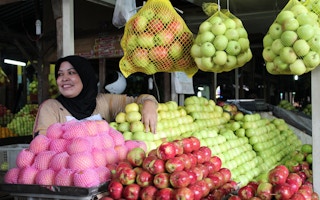As dark clouds gather in the morning sky, Indonesian apple farmer Ali Akhbar hurries to finish spraying pesticides onto his trees before yet another afternoon downpour.
It is officially the start of the dry season in East Java province, but non-stop rains have caused havoc for thousands of apple growers like Akhbar again this year - upsetting the flowering season, damaging blossoms and shrinking harvests.
The unseasonable weather has also caused an increase in pests and diseases, forcing some growers to take out loans to keep up with the surging cost of pesticides to ensure years of work do not go to waste.
“It’s so difficult now - the weather is unpredictable,” Akhbar, 49, told the Thomson Reuters Foundation at Andonosari village in East Java, which is home to the country’s largest apple orchards.
He used to spray pesticides on his crops once a week, but has to do it twice weekly now, and uses more potent chemicals.
After years of similarly unpredictable weather, disappointing harvests are barely enough to cover farmers’ production costs, said Akhbar.
“
Some farmers are trying to move to higher ground for cooler temperatures, but climate change is making the weather erratic and the rainfall is increasing. This weather is the enemy for the apple crop.
Otto Endarto, researcher, Indonesian Citrus and Subtropical Fruits Research Institute
Agriculture experts blame climate change for the prolonged rainy season and a rise in temperatures that pose a serious threat to Indonesian apple farming, a sector that once brought stable incomes for thousands of rural families.
Hotter and rainier
Apples are not native to Indonesia. The fruit is said to have been brought into the country by Dutch colonisers in 1930 and first planted in the Pasuruan regency, where Andonosari village is located.
Today, some of the largest apple-growing areas in the country of 270 million people include Batu, Malang and Pasuruan - all in East Java province which has a subtropical highland climate.
Apple plantations are also a huge draw for agro-tourism in these areas, with Indonesians flocking to the orchards to pick the fruit and enjoy the cooler air.
But from its heyday in the early 1990s, when the number of trees reached nearly 10 million, the sector has quickly declined. There were only about 2.4 million trees left by 2016, according to the latest official statistics.
Successful apple-growing needs just the right amount of rain and sunshine, as too much or too little can severely affect the fruit’s quality.
In Pasuruan, where the dry season usually kicks in from April and lasts until September, farmers plan the flowering and harvesting seasons according to the weather.
They usually start pruning trees in January to prepare for the flowering season in the following two months, and then begin harvesting in April.
Indonesia’s weather agency forecast higher-than-usual rainfall again for 2022, after last year saw 70-100 per cent more than normal levels.
This April, rain continued well into the month and, combined with rising temperatures, severely impacted harvests.
Both rainfall and temperatures have been increasing steadily in Pasuruan over the last decade, data from Indonesia’s statistics agency shows.
Annual precipitation rose to about 4,032 mm (159 inches) in 2021, from 2,600 mm a decade earlier. The average temperature hit 24.4 degrees Celsius (76 Fahrenheit) in 2021, up from 21.8C in 2011.
“The problem is, it’s getting hotter,” said Otto Endarto, a researcher at the Indonesian Citrus and Subtropical Fruits Research Institute at Indonesia’s Ministry of Agriculture.
“Some farmers are trying to move to higher ground for cooler temperatures, but climate change is making the weather erratic and the rainfall is increasing. (This weather) is the enemy for the apple crop,” he added.
Endarto said the rise in temperatures disrupts the way the crops interact with sunlight, water and carbon dioxide to create sugar, leading to diseases such as stem rot and green lice.
The government institute has been researching apple varieties that could adapt to the changing local climate, but so far it has not been successful.
Local officials said they are aware of the impact of climate change on apple-growing activity and have been holding monthly meetings with growers to discuss how to tackle the issue.
Lilik Widji Asri, the local head of the Agriculture Department in Pasuruan, said the problem was also compounded by deteriorating soil quality in the area, and efforts to help farmers with better seeds have yet to yield results.
“If this continues, we don’t know what will be the future for apple plantations here,” she added.
Orange swap
Many apple growers in the region have started switching to planting oranges, which they say are easier to maintain, or have begun growing other produce on the same plot of land.
Since 2017, Ahmad Solikin has replaced most of his apple fields with oranges, and now just one hectare (2.47 acres) of his six-hectare plot has apples.
“Oranges don’t need a lot of treatment,” said the 50-year-old grower, adding he only needs to use pesticides every two weeks on oranges, compared to twice a week for apples.
Production costs can climb to about 100 million rupiah ($6,882) for each hectare of apple trees - and most farmers have to take out loans to cover at least half of that, he added.
“When the harvest falls short, they are forced to sell their livestock or any other possessions they have to cover the debt,” said Solikin.
Many local growers fear apple orchards will become a thing of the past in Indonesia unless the state steps in with financial aid.
“If this continues, we don’t know about the future of apple cultivation in Indonesia,” said Heri Subhan, 45, the chairman of Citra Alami, a local group for farmers.
“Apple farming has lost its glory.”
This story was published with permission from Thomson Reuters Foundation, the charitable arm of Thomson Reuters, that covers humanitarian news, climate change, resilience, women’s rights, trafficking and property rights. Visit http://news.trust.org/climate.










